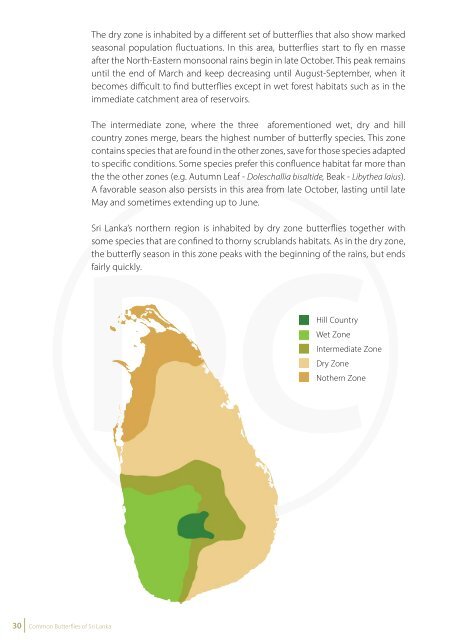Common Butterflies of Sri Lanka
Common Butterflies of Sri Lanka
Common Butterflies of Sri Lanka
Create successful ePaper yourself
Turn your PDF publications into a flip-book with our unique Google optimized e-Paper software.
The dry zone is inhabited by a different set <strong>of</strong> butterflies that also show marked<br />
seasonal population fluctuations. In this area, butterflies start to fly en masse<br />
after the North-Eastern monsoonal rains begin in late October. This peak remains<br />
until the end <strong>of</strong> March and keep decreasing until August-September, when it<br />
becomes difficult to find butterflies except in wet forest habitats such as in the<br />
immediate catchment area <strong>of</strong> reservoirs.<br />
The intermediate zone, where the three aforementioned wet, dry and hill<br />
country zones merge, bears the highest number <strong>of</strong> butterfly species. This zone<br />
contains species that are found in the other zones, save for those species adapted<br />
to specific conditions. Some species prefer this confluence habitat far more than<br />
the the other zones (e.g. Autumn Leaf - Doleschallia bisaltide, Beak - Libythea laius).<br />
A favorable season also persists in this area from late October, lasting until late<br />
May and sometimes extending up to June.<br />
<strong>Sri</strong> <strong>Lanka</strong>’s northern region is inhabited by dry zone butterflies together with<br />
some species that are confined to thorny scrublands habitats. As in the dry zone,<br />
the butterfly season in this zone peaks with the beginning <strong>of</strong> the rains, but ends<br />
fairly quickly.<br />
Hill Country<br />
Wet Zone<br />
Intermediate Zone<br />
Dry Zone<br />
Nothern Zone<br />
3.3 Threats to <strong>Butterflies</strong> and their Conservation<br />
The main threat to butterflies, along with other wildlife at large, is the loss <strong>of</strong><br />
their natural habitat. While the complete destruction <strong>of</strong> a habitat is apparent<br />
to any person, habitat degradation also poses a considerable threat to small<br />
species like butterflies. These delicate butterflies require tremendously specific<br />
micro habitat conditions for their survival. Over-exposure to sunlight caused by<br />
tree felling, adjustments to the chemical composition <strong>of</strong> their feeding material<br />
due to pesticides, changes to population dynamics causes by unexpected<br />
weather conditions, and alterations to habitats caused by invasive plant species<br />
inherently influence the survival <strong>of</strong> these species.<br />
From a conservation point <strong>of</strong> view, butterflies can be divided into two categories.<br />
The most significant <strong>of</strong> these are the category <strong>of</strong> butterflies that need very<br />
specific habitat requirements in pristine forest habitats. In <strong>Sri</strong> <strong>Lanka</strong>, these<br />
habitats are consistently diminishing, and the conservation <strong>of</strong> these spaces is<br />
<strong>of</strong> prime importance. The second category <strong>of</strong> butterflies does not need such<br />
specific conditions, and these can be conserved even within human habitations<br />
through the introduction <strong>of</strong> slight adjustments to the environment.<br />
Any butterfly enthusiast can easily take part in conservation processes focused on<br />
the second category. Firstly, one could gather knowledge about the butterflies in<br />
and around ones area, both by reference and more importantly, individual field<br />
studies. These activities can help with gaining a considerable understanding<br />
<strong>of</strong> butterflies and how one’s home garden can be adapted to attract them by<br />
planting suitable larval food plants and nectar plants, and avoiding the use <strong>of</strong><br />
chemical pesticides. Through this, one can carry on learning about butterflies<br />
even at home, and will no doubt provide extraordinary satisfaction. Those who<br />
are interested in further engaging with the protection <strong>of</strong> butterflies can actively<br />
participate in conservation processes for threatened species.<br />
3.4 The Study <strong>of</strong> <strong>Butterflies</strong><br />
The most important thing one needs to study butterflies is the desire and<br />
commitment to learn about these tiny, fascinating creatures. Keen eyes and<br />
an analytical mind are necessary to further explore ones observations and<br />
environment. If a butterfly is disturbed, the chance <strong>of</strong> studying its activities is<br />
lost and any efforts at doing so will come to an end. It is important to wear dullcoloured<br />
clothing to better blend into the environment. It is also good practice<br />
to bring a note book and a pencil to the field note down any observations. This<br />
will no doubt help in analysing data collected, and in comparing field notes with<br />
published information, or even discussing observations with fellow-enthusiasts.<br />
30 <strong>Common</strong> <strong>Butterflies</strong> <strong>of</strong> <strong>Sri</strong> <strong>Lanka</strong><br />
<strong>Common</strong> <strong>Butterflies</strong> <strong>of</strong> <strong>Sri</strong> <strong>Lanka</strong> 31















